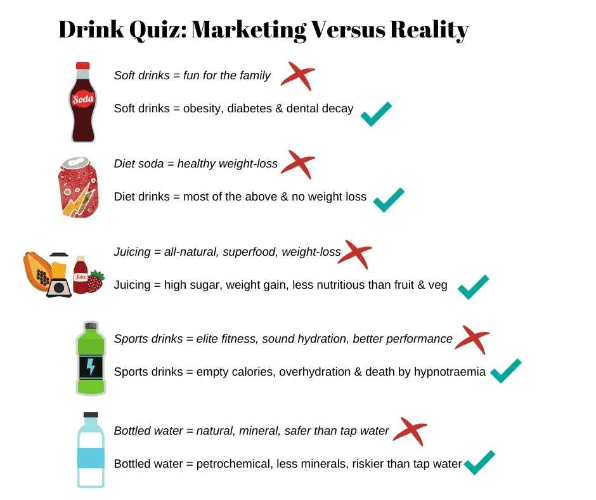My kindergartner
- Mummy, I need a drink. Not the green cup, the bunny cup. Cow milk, not oat milk. I need a pink straw. And ice. You forgot the ice.
Me
- What is this, a kiddie cocktail bar?

The madness of modern drinking
Modern life is a weird beast. Absurd norms take hold without anyone noticing. Eighty years ago, Australians hadn't heard of soft drinks, let alone diet drinks. Now we knock back over 200 litres per person each year. I don't like sweet drinks but I adore coffee and wine. While both have been around for aeons, we drink seven times more than we used to.
The only drink we need is water. In most parts of Australia, you can turn on a tap and get clean safe drinking water straight into your glass. Despite this, we spend billions of dollars each year on substitutes. We add sugar, alcohol, caffeine or chemicals, we bottle it up in factories and then we ship it from one side of the world to the other. The end products add no nutritional value to our diets, create health, industrial and waste problems and damage the planet. How did we get here?
Big Sugar, Big Booze and Big Bottle
Big Tobacco and Big Booze have used clever (and sometimes illegal) marketing for decades. The soft drink industry is called 'Big Sugar' because it uses the same strategies to con us from our money and health. I call the water industry 'Big Bottle' because they use the same playbook. Big Bottle is sometimes identical, and sometimes less healthy, than the tap water it replaces at a price tag 2000 times higher. While it's not addictive like tobacco, booze or sugar, it relies on the same set of fake prestige and false claims to sell itself. Big Bottle also undermines public confidence in our extremely well-regulated and safe municipal water system.
Here's a quick quiz to help you cut through Big Sugar and Big Bottle's marketing BS.
How much CO2e?
Enough preaching. These drinks are unnecessary and unhealthy, but are they unsustainable? How much carbon dioxide and equivalent emissions (CO2e) do they generate?
I recorded my beverages for a week. I omitted dairy drinks and dairy substitutes and tap water, as I'm covering both elsewhere in this project. That left me with coffee, soda water, wine and whiskey. I drink too much booze and caffeine, but at least I've dodged the sugar bullet. My drinks generate almost 300 kilograms CO2e each year. It's almost one-third of my total food impact and I can certainly cut back, particularly in the cold light of a middle-aged hangover.
WWPSD (what would Peter Singer do)? I should cut drink emissions to zero by sticking to tap water. But I went through accidental caffeine deprivation once when the coffee machine in my backpacker ski pad broke (first world problems). It was a ghastly week of withdrawal. I'll spend a week drinking only tap water and homemade coffee instead.
How much CO2e for the average Australian?
The average Australian drinks less coffee, wine and spirits than me but much more bottled water, beer and soft drink. I was surprised to see that these 'soft' options generate similar carbon emissions to wine. Why waste it on the bad stuff?
Emissions from drinks for the average adult came out at a hefty 615 kg CO2e per person per year, almost 45% of emissions from food. It's a massive footprint for something that could be eliminated completely, but it would be unAustralian to expect people to shun every beer or softie they're offered and Pauline Hanson might find out where I live. I'll look at some smart ways to cut down instead.
Think you've got a drinking problem? Climate change drought means war and death in East Africa.
Data uncertainty
Carbon footprinting is always educated guesswork, but I'm less confident about my numbers than usual. I couldn't find any central data on average consumption rates, so I've cobbled together sources from ABS, Statistica and elsewhere. These probably don't match up and shouldn't be used in the way I'm using them. Most of my emission factors come from a UK / US centred paper with broad categories that overlooks the significant differences between, for instance, low-impact instant organic coffee versus high-impact coffee pods. I've also omitted fruit juices because I couldn't find any solid data at all. Check my calculations at your peril.
Spreadsheet calculations, notes and data sources in the 'Notes' section, Week Twenty-Two.
